Appendix A - Division A
A-1.1.1.1.(2) Factory-Built Houses. The Vancouver Building By-law applies the same requirements to site-built and factory-built houses. However, it can often be difficult
determining whether a factory-built house complies with these requirements
once it has been delivered to its construction site because many of the
wall, roof and floor assemblies are closed in and their components cannot be
inspected. CSA Standard CAN/CSA-A277, “Procedure for Certification of
Factory-Built Houses”, was developed to address this problem. It describes
a
procedure whereby an independent certification agency can review the quality
control procedures of a housing factory and make periodic, unannounced
inspections of its products and thus, through suitable labeling, provide
assurance to authorities at the final site that those components which
cannot be inspected on site comply with the code indicated on the label. It
is not a building code, only a procedure for certifying compliance of
factory-built components with a building code or other standard. If a
factory-built house bears a label of an accredited certification agency
indicating that compliance with the Vancouver Building By-law has been
certified using the A277 procedure, the accepting authority will have some
assurance that the hidden components do not need to be inspected again on
site.
On the other hand, portions of the CSA-Z240 series of standards on
mobile homes do resemble a building code. These portions contain
requirements in many of the areas where the Vancouver Building By-law
also has requirements and frequently the requirements are different. Other
portions of the Z240 standards deal with special requirements for mobile
homes related to the fact that these houses are intended to be periodically
moved over roads. The Vancouver Building By-law considers mobile homes
certified to the Z240 standard as acceptable housing and they are permitted
under Clause 1.1.2.2.(1)(g).

A-1.1.1.1.(2) Factory-Built Houses. The British Columbia Building Code applies the same requirements to site-built and factory-built houses. However, it can often be difficult
determining whether a factory-built house complies with these requirements
once it has been delivered to its construction site because many of the
wall, roof and floor assemblies are closed in and their components cannot be
inspected. CSA Standard CAN/CSA-A277, “Procedure for Certification of
Factory-Built Houses”, was developed to address this problem. It describes a
procedure whereby an independent certification agency can review the quality
control procedures of a housing factory and make periodic, unannounced
inspections of its products and thus, through suitable labeling, provide
assurance to authorities at the final site that those components which
cannot be inspected on site comply with the code indicated on the label. It
is not a building code, only a procedure for certifying compliance of
factory-built components with a building code or other standard. If a
factory-built house bears a label of an accredited certification agency
indicating that compliance with the British Columbia Building Code has been
certified using the A277 procedure, the accepting authority will have some
assurance that the hidden components do not need to be inspected again on
site.
On the other hand, portions of the CSA-Z240 series of standards on
mobile homes do resemble a building code. These portions contain
requirements in many of the areas where the British Columbia Building Code
also has requirements and frequently the requirements are different. Other
portions of the Z240 standards deal with special requirements for mobile
homes related to the fact that these houses are intended to be periodically
moved over roads. The British Columbia Building Code considers mobile homes
certified to the Z240 standard as acceptable housing and they are permitted
under Clause 1.1.2.2.(1)(g).
A-1.1.1.2.(1) Application to Existing Buildings. This By-law is most often applied to existing or relocated buildings when an owner wishes to rehabilitate a building, change its use, or build an
addition, or when an enforcement authority decrees that a building or class
of buildings be altered for reasons of public safety. It is not intended
that the VBBL be used to enforce the retrospective application of new
requirements to existing buildings or existing portions of relocated
buildings, unless specifically required by local regulations or bylaws. For
example, although the VFBL could be interpreted to require the installation
of fire alarm, standpipe and hose, and automatic sprinkler systems in an
existing building for which there were no requirements at the time of
construction, the VFBL should not be applied in this manner to these
buildings unless the Chief Building Official has determined that there
is an inherent threat to occupant safety and has issued an order to
eliminate the unsafe condition, or where substantial changes or additions
are being made to an existing building or the occupancy has been changed.
(See also Appendix Note A-1.1.1.1.(1) of Division A of the VFBL.)
Relocated buildings that have been in use in another location for a number
of years can be considered as existing buildings, in part, and the same
analytical process can be applied as for existing buildings. It should be
noted,
however, that a change in occupancy may affect some requirements (e.g. loads
and
fire separations) and relocation to an area with different wind, snow or
earthquake loads will require the application of current By-law requirements.
Depending on the construction of the building and the changes in load,
structural modifications may be required. Similarly, parts of a relocated
or
existing building that are reconstructed, such as foundations and basements,
or
parts being modified are required to be built to current by-law.
Whatever the reason, By-law application to existing or relocated buildings
requires careful consideration of the level of safety needed for that building.
This consideration involves an analytical process similar to that required
to
assess alternative design proposals for new construction. See Clause 1.2.1.1.(1)(b) and its Appendix Note for information on achieving compliance with the By-law using
alternative solutions.
In developing By-law requirements for new buildings, consideration has been given
to the cost they impose on a design in relation to the perceived benefits in
terms
of safety. The former is definable; the latter difficult to establish on a
quantitative basis. In applying the By-law requirements to an existing building, the
benefits derived are the same as in new buildings. On the other hand, the increased
cost of implementing in an existing building a design solution that would normally
be intended for a new building may be prohibitive.
The successful application of By-law requirements to existing construction
becomes a matter of balancing the cost of implementing a requirement with the
relative importance of that requirement to the overall By-law objectives. The degree
to which any particular requirement can be relaxed without affecting the intended
level of safety of the By-law requires considerable judgment on the part of both the
designer and the Chief Building Official.
Further information on the application of By-law requirements to existing or
relocated buildings may be found in the following publications:
- User's Guide - NBC 1995, Fire Protection, Occupant Safety and Accessibility
(Part 3)
- Guidelines for Application of Part 3 of the National Building Code of Canada to
Existing Buildings
- “Commentary L, Application of NBC Part 4 of Division B for the Structural
Evaluation and Upgrading of Existing Buildings” of the User's Guide - NBC
2005,
Structural Commentaries (Part 4 of Division B)
- User's Guide - NBC 1995, Application of Part 9 to Existing Buildings
- Canadian Building Digest No. 230, “Applying Building Codes to Existing
Buildings”
These publications can be ordered through Client Services, Institute for
Research in Construction, National Research Council of Canada, Ottawa, Ontario
K1A
0R6, or through the Web site at www.nationalcodes.ca.
Heritage Buildings
Many local governments have identified conservation of
selected heritage properties, or protection of the heritage character of
certain areas, as being community planning objectives. The Province's
planning objectives and growth strategy encourage and support local
government in this effort. The key is to find ways to make restoration
and rehabilitation of heritage buildings economically viable for the
properties' owners.
It is generally recognized that the present Building By-law
was primarily written for new construction and provides for a
performance level that is significantly higher than what exists with
many older buildings. To apply present Building By-law provisions to
existing buildings is, in many cases, impractical and with heritage
buildings may compromise historic appearances or authenticity.
Therefore, [. . .] Alternate Compliance Methods in Part 10 were developed to
provide alternate methods for complying with the performance level
intended by the Building By-law. The use of sprinklers is advocated as one
of the primary methods in assuring this performance level for heritage
buildings. Sprinkler systems not only control the fire which aids
evacuation, but also provides the added benefit of protecting the
building from possible destruction by fire.
The Alternative Compliance Methods represents
some of the ways that restoration and rehabilitation of heritage
buildings can be facilitated without compromising the objectives of the
Building By-law. Only buildings which have been identified by the
Provincial or local government are included in the definition of
“heritage building.” For these buildings, conservation is also a public
objective. Heritage buildings often offer unique problems and
opportunities, and each situation must be assessed individually.
The use of the Alternate Compliance Methods in Part 10 is not mandatory and an owner may choose to apply Division B or other Section in Part 10,
may wish to apply alternate solutions as permitted by Clause 1.2.1.1.(1)(b), or may wish to combine these options.

A-1.1.1.1.(1) Application to Existing Buildings. This Code is most often applied to existing or relocated buildings when an owner wishes to rehabilitate a building, change its use, or build an
addition, or when an enforcement authority decrees that a building or class
of buildings be altered for reasons of public safety. It is not intended
that the BCBC be used to enforce the retrospective application of new
requirements to existing buildings or existing portions of relocated
buildings, unless specifically required by local regulations or bylaws. For
example, although the BCFC could be interpreted to require the installation
of fire alarm, standpipe and hose, and automatic sprinkler systems in an
existing building for which there were no requirements at the time of
construction, the BCFC should not be applied in this manner to these
buildings unless the authority having jurisdiction has determined that there
is an inherent threat to occupant safety and has issued an order to
eliminate the unsafe condition, or where substantial changes or additions
are being made to an existing building or the occupancy has been changed.
(See also Appendix Note A-1.1.1.1.(1) of Division A of the BCFC.)
Relocated buildings that have been in use in another location for a number
of years can be considered as existing buildings, in part, and the same
analytical process can be applied as for existing buildings. It should be
noted,
however, that a change in occupancy may affect some requirements (e.g. loads
and
fire separations) and relocation to an area with different wind, snow or
earthquake loads will require the application of current code requirements.
Depending on the construction of the building and the changes in load,
structural modifications may be required. Similarly, parts of a relocated
or
existing building that are reconstructed, such as foundations and basements,
or
parts being modified are required to be built to current codes.
Whatever the reason, Code application to existing or relocated buildings
requires careful consideration of the level of safety needed for that building.
This consideration involves an analytical process similar to that required
to
assess alternative design proposals for new construction. See Clause 1.2.1.1.(1)(b) and its Appendix Note for information on achieving compliance with the Code using
alternative solutions.
In developing Code requirements for new buildings, consideration has been given
to the cost they impose on a design in relation to the perceived benefits in
terms
of safety. The former is definable; the latter difficult to establish on a
quantitative basis. In applying the Code requirements to an existing building,
the
benefits derived are the same as in new buildings. On the other hand, the increased
cost of implementing in an existing building a design solution that would normally
be intended for a new building may be prohibitive.
The successful application of Code requirements to existing construction
becomes a matter of balancing the cost of implementing a requirement with the
relative importance of that requirement to the overall Code objectives. The
degree
to which any particular requirement can be relaxed without affecting the intended
level of safety of the Code requires considerable judgment on the part of both
the
designer and the authority having jurisdiction.
Further information on the application of Code requirements to existing or
relocated buildings may be found in the following publications:
- User's Guide - NBC 1995, Fire Protection, Occupant Safety and Accessibility
(Part 3)
- Guidelines for Application of Part 3 of the National Building Code of Canada to
Existing Buildings
- “Commentary L, Application of NBC Part 4 of Division B for the Structural
Evaluation and Upgrading of Existing Buildings” of the User's Guide - NBC
2005,
Structural Commentaries (Part 4 of Division B)
- User's Guide - NBC 1995, Application of Part 9 to Existing Buildings
- Canadian Building Digest No. 230, “Applying Building Codes to Existing
Buildings”
These publications can be ordered through Client Services, Institute for
Research in Construction, National Research Council of Canada, Ottawa, Ontario
K1A
0R6, or through the Web site at www.nationalcodes.ca.
Heritage Buildings
Many local governments have identified conservation of
selected heritage properties, or protection of the heritage character of
certain areas, as being community planning objectives. The Province's
planning objectives and growth strategy encourage and support local
government in this effort. The key is to find ways to make restoration
and rehabilitation of heritage buildings economically viable for the
properties' owners.
It is generally recognized that the present Building Code
was primarily written for new construction and provides for a
performance level that is significantly higher than what exists with
many older buildings. To apply present Building Code provisions to
existing buildings is, in many cases, impractical and with heritage
buildings may compromise historic appearances or authenticity.
Therefore, the Table of Alternate Compliance Methods was developed to
provide alternate methods for complying with the performance level
intended by the Building Code. The use of sprinklers is advocated as one
of the primary methods in assuring this performance level for heritage
buildings. Sprinkler systems not only control the fire which aids
evacuation, but also provides the added benefit of protecting the
building from possible destruction by fire.
This Table of Alternative Compliance Methods represents
some of the ways that restoration and rehabilitation of heritage
buildings can be facilitated without compromising the objectives of the
Building Code. Only buildings which have been identified by the
Provincial or local government are included in the definition of
“heritage building.” For these buildings, conservation is also a public
objective. Heritage buildings often offer unique problems and
opportunities, and each situation must be assessed individually.
The use of the Alternate Compliance Methods in Table A-1.1.1.1. is not mandatory and an owner may choose to apply Division B,
may wish to apply alternate solutions as permitted by Clause 1.2.1.1.(1)(b), or may wish to combine these options.
Table A-1.1.1.1.
Alternate
Compliance Methods for Heritage Buildings
|
| No. |
Code Requirement |
Alternate Compliance Method |
| 1 |
Fire Separations
3.1.3.1.(1) and Table 3.1.3.1., 9.10.9.
2 h fire separation required between some major occupancies.
|
Except for F1 occupancies, 1 h fire separation is
acceptable, if the building is sprinklered.
|
| 2 |
Fire Separations
3.1.3.1.(1) and Table 3.1.3.1., 9.10.9.
1 h fire separation required between some major occupancies.
|
1/2 h fire separation is acceptable if the
building is sprinklered.
|
| 3 |
Noncombustible Construction
3.1.5. and 9.10.6.1.
All materials used in noncombustible construction must be noncombustible unless otherwise permitted.
|
1. Roofs may be of combustible construction
provided the building is sprinklered.
2. Up to 10% gross
floor area to a maximum of 10% of any one floor area may be of
combustible construction provided the building is sprinklered.
|
| 4 |
Fire-resistance Rating
3.1.7.1.(1), 9.10.3.1.
Where a material, assembly of materials or structural member is required to have a fire resistance
rating it shall be tested in accordance with CAN/ULC-S101
|
A fire-resistance rating may also be used based
on:
1. HUD No. 8 Guideline on Fire Ratings of Archaic
Materials and Assemblies.
2. Fire Endurance of Protected
Steel Columns and Beams, DBR Technical Paper No. 194.
3.
Fire Endurance of Unit Masonry Walls, DBR Technical Paper No.
207.
4. Fire Endurance of Light-Framed and Miscellaneous
Assemblies, DBR Technical Paper No. 222
|
| 5 |
Rating of Supporting Construction
3.1.7.5., 9.10.8.3.
Supporting assemblies to have fire resistance rating at least equivalent to that of the supported
floor.
|
Heavy timber construction is permitted to have a
fire resistance rating less than would be required by the Code
provided the building:
(a) is sprinklered, and
(b)
does not exceed 6 storeys in building height.
|
| 6 |
Continuity Of Fire Separations
3.1.8.3.(1) and (2), 9.10.9.2.
Fire separations are required to be continuous above the ceiling
space.
|
Fire separations are not required to be continuous
above the ceiling space where:
(a) the ceiling space is
non-combustible construction,
(b) both fire compartments
are sprinklered, or
(c) the ceiling has a minimum rating of
30 minutes.
|
| 7 |
Wired Glass
3.1.8.5.(1) and 3.1.8.14.(2), 9.10.13.1. and 9.10.13.5.
6 mm wired glass in steel frame required in fire separations.
|
For fixed transoms or sidelights, 6 mm wired glass
fixed to a wood frame of at least 50 mm thickness with steel
stops is permitted in a required fire separation.
|
| 8 |
Mezzanines
3.2.1.1.(3) to (6), 9.10.4.1.
Mezzanines enclosing more than 10% above the horizontal plane
are considered as storey in building height.
|
Enclosed mezzanines may be up to 40% of the storey
in which they occur and not be considered a storey in building
height if the building is sprinklered.
|
| 9 |
Building Height
3.2.2.20. to 3.2.2.83.
Noncombustible construction required for buildings over 3 storeys in building height.
|
Buildings may be of combustible construction up to
6 storeys provided:
(a) the building is sprinklered,
(b) the building contains Group C, D, E, F2 or F3 occupancies,
and
(c) floor assemblies not required to exceed 1 h fire
separation requirements may be of heavy timber construction.
|
| 10 |
Spatial Separation
3.2.3., 9.10.14.
The area of unprotected opening shall not exceed the limits in Tables 3.2.3.1.A. to 3.2.3.1.D. |
The area of unprotected opening is not limited
provided:
(a) the limiting distance is a minimum 1 m,
(b) the building has a supervised sprinkler system in
conformance with Sentence 3.2.4.9.(2), and
(c) the sprinkler system is connected to the fire department in conformance with
Sentence 3.2.4.7.(4).
|
| 11 |
Construction of Exposing Building Face
3.2.3.7., 9.10.14.5.
The exposing building face is required to have a fire resistance rating and/or be of noncombustible construction.
|
Exposing building face is not required to have a
fire resistance rating if the building is sprinklered. Also, the
exposing building face is not required to be of noncombustible
construction if it is protected by an exterior sprinkler system
conforming to NFPA 13.
|
| 12 |
Roof Covering Rating
3.1.15.2.(1)
Class A, B or C roof covering in conformance with CAN/ULC-S107 required.
|
For existing roofs not covered by a Class A, B or
C roofing a manually operated deluge system in accordance with
NFPA 13 is permitted.
|
| 13 |
Smoke Alarms
3.2.4.20(5)., 9.10.19.3.(1)
Smoke alarms are required to be connected to an electric circuit.
|
Smoke alarms may be battery operated in single
family homes only.
|
| 14 |
Interconnected Floor Space
3.2.8., 9.10.1.2.(6) |
1. Open stairs in buildings of maximum 4 storeys
in building height need not comply with Subsection 3.2.8. provided:
(a) the building contains a Group C or D
occupancy,
(b) the building is sprinklered with fast
response sprinklers,
(c) corridors opening into the
interconnected floor space are separated from the interconnected
floor space by a fire separation with the rating required for
the corridor, and
(d) smoke detectors are installed in the
rooms opening into the interconnected floor space and the smoke
detectors are connected to the fire alarm system.
2. Open
stairs in buildings of maximum 3 storeys in building height, or
first 2 storeys and basement, need not comply with Subsection
3.2.8. provided:
(a) the building contains a Group C or D
occupancies,
(b) the building is sprinklered with fast
response sprinklers,
(c) smoke detectors are installed in
the rooms opening into the interconnected floor space and the
smoke detectors are connected to the fire alarm system, and
(d) at least one means of egress is not through the
interconnected floor space.
|
| 15 |
Separation of Suites
3.3.1.1., 9.10.9.13., 9.10.9.14.
Suites are required to be separated from adjoining suites by 3/4 h or 1 h rated fire separations.
|
Existing fire separations of 1/2 h, such as wood
lath and plaster in good condition, are acceptable in
sprinklered buildings not exceeding 6 storeys in building
height.
|
| 16 |
Corridor fire separation
3.3.1.4., 9.10.9.15.
Public corridors are required to be separated from the remainder of the building by a fire
separation having a fire resistance rating of at least 3/4 h.
|
Existing corridors with 1/2 h fire resistance
ratings, such as wood lath and plaster in good condition, are
acceptable in residential occupancies provided the
building:
(a) does not exceed 6 storeys in building height,
and
(b) is fully sprinklered with fast response sprinklers.
|
| 17 |
Corridor Width
3.3.1.9. and 3.4.3., 9.9.3.3.
Public corridors and exit corridors are permitted to have a minimum width of 1 100 mm.
|
Public corridors and exit corridors are permitted
with a minimum width of 800 mm provided:
(a) the occupant
load of the building is maximum 20 people, and
(b) the
building does not exceed 3 storeys in building height.
|
| 18 |
Door Swing
3.3.1.10. and 3.4.6.11., 9.9.6.5.
Doors required to swing in the direction of exit travel.
|
2nd egress door from a room is not required to
swing in the direction of exit travel provided:
(a) the
building is sprinklered and the system is supervised in
conformance with Sentence 3.2.4.9.(2), and
(b) the occupant load of the building is maximum 100 people.
|
| 19 |
Stairs, Ramps, Handrails and Guards
3.3.1.14., 3.3.1.16., 3.3.1.18., 3.4.6.4. to 3.4.6.6., 9.8 |
Existing conditions that do not comply fully with
the requirements are permitted if they are acceptable to the
authority having jurisdiction.
|
| 20 |
Transparent Doors and Panels
3.3.1.19., 9.6.6.2.
Glass in doors and sidelights are required to be protected by guards and to be safety glass.
|
Existing glass or transparent panels that do not
comply fully with the requirements are permitted if sufficiently
discernible or guards are provided in hazardous situations.
|
| 21 |
Dead-end Corridors
3.3.1.9.(7), 9.9.7.3.
Dead-end corridors are permitted to a maximum length of 6 m.
|
1. Dead-end corridors are permitted to a maximum
length of 10 m in Group C occupancies provided:
(a) the
building is sprinklered with fast response sprinklers, and
(b) smoke detectors are installed in the corridor system.
2. Dead-end corridors are permitted to a maximum of 15 m in
length in Group D, E, F2 and F3 occupancies provided:
(a)
the building is sprinklered with fast response sprinklers,
and
(b) smoke detectors are installed in the corridor
system.
|
| 22 |
Exits
3.4.2.1., 9.9.8.2.
Floor areas shall be served by not fewer than 2 exits except as permitted by 3.4.2.1.(2). |
Floor areas may be served by a single exit within
the limits of 3.4.2.1.(2) provided:
(a) the building does not exceed 3 storeys in building height,
(b) the building is
sprinklered with fast response sprinklers, and
(c) all
floor areas are protected by a system of smoke detectors
connected to a fire alarm system.
|
| 23 |
Reduction of Exit Width
3.4.3.3.(2), 9.9.6.1.
Swinging doors in their swing shall not reduce the effective width of exit stairs and landings to less
than 750 mm.
|
Existing swinging doors in their swing are
permitted to reduce the effective width of exit stairs and
landings to a minimum of 550 mm provided:
(a) they serve
Group C or D occupancies,
(b) the building does not exceed
4 storeys in building height, and
(c) the building is
sprinklered.
|
| 24 |
Fire Separation of Exits
3.4.4.1., 9.9.4.
Exits are required to be separated from the remainder of the floor area by a fire separation having a
fire-resistance rating of not less than 3/4h.
|
1. Buildings of 3 storeys or less may have exits
that are separated by a fire separation that does not have a
fire-resistance rating provided:
(a) the building is
sprinklered with fast response sprinklers, and
(b) the
sprinkler system is supervised in accordance with
Sentence 3.2.4.9.(2).
2. Buildings not exceeding 6 storeys in building height may have exits that are separated by a 3/4 h fire separation
provided the building is sprinklered.
|
| 25 |
Exits Through Lobbies
3.4.4.2., 9.9.8.5.
Rooms adjacent to the lobby are required to be separated by a fire separation.
|
Rooms adjacent to the lobby are not required to be
separated by a fire separation provided:
(a) the floor area
is sprinklered with fast response sprinklers, and
(b) smoke
detectors are installed in the adjacent rooms.
|
| 26 |
Rooms Opening into Exit
3.4.4.4.(7), 9.9.5.9.
Service rooms and ancillary rooms are not permitted to open directly into an exit.
|
Service rooms and ancillary rooms may open
directly into an exit provided:
(a) the room is sprinklered
with fast response sprinklers, and
(b) weatherstripping is
installed on the door to prevent the passage of smoke.
|
| 27 |
Illumination of Exit Signs
3.4.5.1.(2), 9.9.10.5.
Exit signs are required to be illuminated continuously while the building is occupied.
|
Where exit signage may compromise historic
appearances, or authenticity of displays, exit signs may be
installed to light only on an emergency condition, such as by
the fire alarm system or due to power failure.
|
| 28 |
Clearance from Exit Doors
3.4.6.10.(1), 9.9.6.6.
Stair risers shall not be closer than 300 mm from an exit door.
|
Except as permitted in Sentences 3.4.6.10.(2) or 9.9.6.6.(2), existing exit doors shall not extend beyond the first riser.
|
| 29 |
Fire Escapes
3.4.7., 9.9.2.1.(2)
Fire escapes are required to conform to Subsection 3.4.7.
|
Existing fire escapes that do not completely
conform to Subsection 3.4.7. are acceptable provided:
(a) the fire
escapes are acceptable and
(b) the building is sprinklered.
|
| 30 |
Fire Escape Construction
3.4.7.2., 9.9.2.1.(2) |
Existing combustible fire escapes are permitted if
the building is permitted to be of combustible construction by
Part 3, Part 9 or by these Compliance Tables.
|
| 31 |
Protection of Fire Escapes
3.4.7.4., 9.9.2.1.(2)
Openings in the exterior wall adjacent to the fire escape are required to be protected by
closures.
|
Existing openings in the exterior wall adjacent to
the fire escape are not required to be protected by closures
provided:
(a) the building is sprinklered, and
(b) a
sprinkler head is located within 1.5 m of the opening required
to be protected by Article 3.4.7.4. |
| 32 |
Vertical Service Space
3.6.3.1.
Vertical service spaces are required to be separated from the
adjacent floor area by a rated fire separation.
|
Existing vertical service spaces that do not
completely conform to the rated fire separation requirements are
acceptable provided the vertical service spaces are sprinklered.
|
| 33 |
Height and Area of Rooms
3.7.1., 9.5.
The height and area of rooms are required to comply to minimum dimension requirements.
|
Existing rooms are not required to comply to the
minimum dimension requirements of Subsection 3.7.1. or Section 9.5. |
| 34 |
Washroom Requirements
3.7.2., 9.31
Buildings are required to be provided with a minimum number of washroom fixtures.
|
Existing facilities are not required to completely
comply to the requirements of Subsection 3.7.2. or Section 9.31. provided it is acceptable to the authority having
jurisdiction.
|
| 35 |
Access for Persons with Disabilities
3.8 |
Article 3.8.4.5. shall apply to existing buildings. |
| 36 |
Seismic Anchorage of Exterior Decoration
4.1.8. |
Existing exterior decorations are not required to
fully comply to the anchorage requirements of Subsection 4.1.8. provided:
(a) adequate means of protection
is provided, or
(b) there is no exposure to the public.
|
| 37 |
Mechanical Systems
Part 6 and Part 7
|
Existing mechanical systems in buildings are not
required to fully comply to the requirements of Parts 6 or 7
provided:
(a) it is not an unsafe condition and
(b) it
is acceptable to the authority having jurisdiction.
|
A-1.2.1.1.(1)(a) By-law Compliance via Acceptable Solutions. If a building design (e.g. material, component, assembly or system) can be shown to meet all provisions of the applicable acceptable solutions in Division
B
(e.g. it complies with the applicable provisions of a referenced standard), it
is
deemed to have satisfied the objectives and functional statements linked to those
provisions and thus to have complied with that part of the By-law. In fact, if it can
be determined that a design meets all the applicable acceptable solutions in
Division B, there is no need to consult the objectives and functional statements
in
Division A to determine its compliance.

A-1.2.1.1.(1)(a) Code Compliance via Acceptable Solutions. If a building design (e.g. material, component, assembly or system) can be shown to meet all provisions of the applicable acceptable solutions in Division
B
(e.g. it complies with the applicable provisions of a referenced standard), it
is
deemed to have satisfied the objectives and functional statements linked to those
provisions and thus to have complied with that part of the Code. In fact, if it
can
be determined that a design meets all the applicable acceptable solutions in
Division B, there is no need to consult the objectives and functional statements
in
Division A to determine its compliance.
A-1.2.1.1.(1)(b) By-law Compliance via Alternative Solutions. Where a design differs from the acceptable solutions in Division B, then it should be treated as an “alternative solution.” A proponent of an alternative
solution must demonstrate that the alternative solution addresses the same issues
as
the applicable acceptable solutions in Division B and their attributed objectives
and functional statements. However, because the objectives and functional statements
are entirely qualitative, demonstrating compliance with them in isolation is
not
possible. Therefore, Clause 1.2.1.1.(1)(b) identifies the principle that Division B establishes the
quantitative performance targets that alternative solutions must meet. In many
cases, these targets are not defined very precisely by the acceptable solutions
—
certainly far less precisely than would be the case with a true performance code,
which would have quantitative performance targets and prescribed methods of
performance measurement for all aspects of building performance. Nevertheless,
Clause 1.2.1.1.(1)(b) makes it clear that an effort must be made to demonstrate that an alternative solution
will
perform as well as a design that would satisfy the applicable acceptable solutions
in Division B – not “well enough” but “as well as.”
In this sense, it is Division B that defines the boundaries between acceptable
risks and the “unacceptable” risks referred to in the statements of the By-law's
objectives, i.e. the risk remaining once the applicable acceptable solutions in
Division B have been implemented represents the residual level of risk deemed
to be
acceptable by the broad base of Canadians who have taken part in the consensus
process used to develop the By-law.
Level of Performance
Where Division B offers a choice between several possible designs,
it is likely that these designs may not all provide exactly the same level of
performance. Among a number of possible designs satisfying acceptable solutions
in Division B, the design providing the lowest level of performance should
generally be considered to establish the minimum acceptable level of performance
to be used in evaluating alternative solutions for compliance with the By-law.
Sometimes a single design will be used as an alternative solution
to several sets of acceptable solutions in Division B. In this case, the level
of performance required of the alternative solution should be at least
equivalent to the overall level of performance established by all the applicable
sets of acceptable solutions taken as a whole.
Each provision in Division B has been analyzed to determine to what
it applies and what it is intended to achieve. The resultant application and
intent statements clarify what undesirable results each provision seeks to
preclude. These statements are not a legal component of the By-law, but are
advisory in nature, and can help By-law users establish performance targets for
alternative solutions. They are published in the electronic and CD versions of
the By-law.
Areas of Performance
A subset of the acceptable solutions in Division B may establish
criteria for particular types of designs (e.g. certain types of materials,
components, assemblies, or systems). Often such subsets of acceptable solutions
are all attributed to the same objective: Fire Safety for example. In some
cases, the designs that are normally used to satisfy this subset of acceptable
solutions might also provide some benefits that could be related to some other
objective: Fire Protection of the Building for example. However, if none of the
applicable acceptable solutions are linked to Objective OP1, Fire Protection
of
the Building, it is not necessary that alternative solutions proposed to replace
these acceptable solutions provide a similar benefit related to Fire Protection
of the Building. In other words, the acceptable solutions in Division B
establish acceptable levels of performance for compliance with the By-law only in
those areas defined by the objectives and functional statements attributed to
the acceptable solutions.
Applicable Acceptable Solutions
In demonstrating that an alternative solution will perform as well
as a design that would satisfy the applicable acceptable solutions in Division
B, its evaluation should not be limited to comparison with the acceptable
solutions to which an alternative is proposed. It is possible that acceptable
solutions elsewhere in the By-law also apply. The proposed alternative solution
may be shown to perform as well as the most apparent acceptable solution which
it is replacing but may not perform as well as other relevant acceptable
solutions. For example, an innovative sheathing material may perform adequately
as sheathing in a wall system that is braced by other means but may not perform
adequately as sheathing in a wall system where the sheathing must provide the
structural bracing. All applicable acceptable solutions should be taken into
consideration in demonstrating the compliance of an alternative
solution.

A-1.2.1.1.(1)(b) Code Compliance via Alternative Solutions. Where a design differs from the acceptable solutions in Division B, then it should be treated as an “alternative solution.” A proponent of an alternative
solution must demonstrate that the alternative solution addresses the same issues
as
the applicable acceptable solutions in Division B and their attributed objectives
and functional statements. However, because the objectives and functional statements
are entirely qualitative, demonstrating compliance with them in isolation is
not
possible. Therefore, Clause 1.2.1.1.(1)(b) identifies the principle that Division B establishes the
quantitative performance targets that alternative solutions must meet. In many
cases, these targets are not defined very precisely by the acceptable solutions
—
certainly far less precisely than would be the case with a true performance
code,
which would have quantitative performance targets and prescribed methods of
performance measurement for all aspects of building performance. Nevertheless,
Clause 1.2.1.1.(1)(b) makes it clear that an effort must be made to demonstrate that an alternative solution
will
perform as well as a design that would satisfy the applicable acceptable solutions
in Division B – not “well enough” but “as well as.”
In this sense, it is Division B that defines the boundaries between acceptable
risks and the “unacceptable” risks referred to in the statements of the Code's
objectives, i.e. the risk remaining once the applicable acceptable solutions
in
Division B have been implemented represents the residual level of risk deemed
to be
acceptable by the broad base of Canadians who have taken part in the consensus
process used to develop the Code.
Level of Performance
Where Division B offers a choice between several possible designs,
it is likely that these designs may not all provide exactly the same level
of
performance. Among a number of possible designs satisfying acceptable solutions
in Division B, the design providing the lowest level of performance should
generally be considered to establish the minimum acceptable level of performance
to be used in evaluating alternative solutions for compliance with the Code.
Sometimes a single design will be used as an alternative solution
to several sets of acceptable solutions in Division B. In this case, the level
of performance required of the alternative solution should be at least
equivalent to the overall level of performance established by all the applicable
sets of acceptable solutions taken as a whole.
Each provision in Division B has been analyzed to determine to what
it applies and what it is intended to achieve. The resultant application and
intent statements clarify what undesirable results each provision seeks to
preclude. These statements are not a legal component of the Code, but are
advisory in nature, and can help Code users establish performance targets for
alternative solutions. They are published in the electronic and CD versionsof
the Code.
Areas of Performance
A subset of the acceptable solutions in Division B may establish
criteria for particular types of designs (e.g. certain types of materials,
components, assemblies, or systems). Often such subsets of acceptable solutions
are all attributed to the same objective: Fire Safety for example. In some
cases, the designs that are normally used to satisfy this subset of acceptable
solutions might also provide some benefits that could be related to some other
objective: Fire Protection of the Building for example. However, if none of
the
applicable acceptable solutions are linked to Objective OP1, Fire Protection
of
the Building, it is not necessary that alternative solutions proposed to replace
these acceptable solutions provide a similar benefit related to Fire Protection
of the Building. In other words, the acceptable solutions in Division B
establish acceptable levels of performance for compliance with the Code only
in
those areas defined by the objectives and functional statements attributed
to
the acceptable solutions.
Applicable Acceptable Solutions
In demonstrating that an alternative solution will perform as well
as a design that would satisfy the applicable acceptable solutions in Division
B, its evaluation should not be limited to comparison with the acceptable
solutions to which an alternative is proposed. It is possible that acceptable
solutions elsewhere in the Code also apply. The proposed alternative solution
may be shown to perform as well as the most apparent acceptable solution which
it is replacing but may not perform as well as other relevant acceptable
solutions. For example, an innovative sheathing material may perform adequately
as sheathing in a wall system that is braced by other means but may not perform
adequately as sheathing in a wall system where the sheathing must provide the
structural bracing. All applicable acceptable solutions should be taken into
consideration in demonstrating the compliance of an alternative
solution.
A-1.3.3.4.(1) Buildings Divided by Firewalls. This concept relates to the provisions directly regulated by this By-law and does not apply to electrical service entrance requirements, which are regulated by
other
documents.

A-1.3.3.4.(1) Buildings Divided by Firewalls. This concept relates to the provisions directly regulated by this Code and does not apply to electrical service entrance requirements, which are regulated by
other
documents.
A-1.3.3.4.(2) Buildings on Sloping Sites. Application of the definition of grade to stepped buildings on sloping sites often results in such buildings being designated as being greater than 3 storeys
in
building height even though there may be only 2 or 3 storeys at any one location.
The diagrams below illustrate this application compared to a similar building
on a
flat site.
Under this Sentence, Building A can be considered as being 3 storeys in
building height instead of 6 storeys in building height. Both Building A and B
are
comparable with regard to fire safety and egress.
This relaxation applies to the determination of building height only. All other
requirements continue to apply as appropriate.
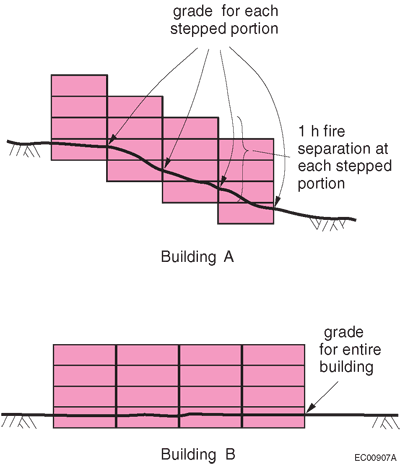
Figure A-1.3.3.4.(2)
Application of the definition of grade
Under this Sentence, Building A can be considered as being 3 storeys in
building height instead of 6 storeys in building height. Both Building A and
Building B are comparable with regard to fire safety and egress. This relaxation
applies to the determination of building height only. All other requirements
continue to apply as appropriate.
A-1.3.3.6.(2)(k) Portable Classroom Exemption. This exemption is based on the following considerations
- the building area is less than 100 m2 in building area and each unit is provided with exiting directly to the exterior,
- the building is constructed with smoke detection in all major rooms and with adequate
portable fire extinguishers,
- the building is properly supervised with a practised and drilled fire safety plan
and with supervisory staff fully trained in securing the rapid evacuation of the facilities
upon initiation of any alarm device, and
- the building, its construction type and any required fire ratings are otherwise in
full conformance with the requirements of the Vancouver Building By-law.
A-1.3.3.7.(2) Energy Utilization By-law. See Building Bulletin 2004-008-BU for more details on the implementation of the Energy Utilization By-law to the ASHRAE 90.1-2001 edition.
A-1.4.1.2.(1) Defined Terms.
Auxiliary Water Supply
The auxiliary water supply may include water from a
secondary potable water supply or from any natural source, such as a
well, lake, spring, stream or harbour. It may also include waste
water (but not sanitary drainage) from industrial processes, such as
cooling towers, or from storm retention ponds. These sources may be
polluted or contaminated and constitute an unacceptable water source
over which the primary water purveyor does not have sanitary
control. It is generally accepted that there are two categories of
auxiliary water supply:
- any public potable water supply over which the primary water
purveyor does not have sanitary control, or
- any private water supply, other than the primary potable water
supply, that is on or available to the premises.
Class 3 Fire Sprinkler/Standpipe Systems
In Class 3 fire sprinkler/standpipe systems, water is
supplied to the storage facilities from the public water supply and
is maintained in potable condition. Class 3 fire sprinkler/standpipe
systems resemble Class 1 fire sprinkler/standpipe systems in all
other respects.
Clear-Water Waste
Examples of clear-water waste are the waste waters
discharged from a drinking fountain, cooling jacket, air conditioner or
relief valve outlet.
Designated Flood Plain
Designated Flood Plain. Buildings(1) are not permitted to be constructed where the underside of a floor system or the top of a concrete slab used for habitation, business, or storage of goods could become
damaged by flood water. The following criteria are guidelines to minimise the potential
for flood damage.
a) The Fraser River and False Creek
- The underside of a floor system or the top of a concrete slab as indicated above should
not be lower than 3.5 metres Greater Vancouver Regional District datum for buildings
within 300 metres of the natural boundary.
- The underside of a floor system or the top of a concrete slab as indicated above should
not be lower than 3.0 metres Greater Vancouver Regional District datum for building
more than 300 metres from the natural boundary.
b) Burrard Inlet and English Bay
- The underside of a floor system or the top of a concrete slab as indicated above should
not be lower than 3.5 metres Greater Vancouver Regional District datum plus an additional
elevation allowance for wave run-up(2) as determined by a Professional Engineer, for buildings within 15 metres of the natural boundary.
- The underside of a floor system or the top of a concrete slab as indicated above should
not be lower than 3.5 metres Greater Vancouver Regional District datum for buildings
more than 15 metres from the natural boundary.
These setback and flood construction elevation requirements would not apply to on-loading
and off-loading facilities associated with a water-oriented industry. The setback
requirement may be reduced subject to the completion of an appropriate engineering
study, the construction of any required erosion protection works designed by a Professional
Engineer and the acceptance of the City Engineer. Technical advice may be obtained
from the Regional Water Manager, Ministry of Environment and Parks.
Any construction materials used below the guideline flood construction elevation should
be constructed from concrete, masonry, corrosion-protected steel or pressure-treated
wood. Heating and electrical appliances (including switches and outlets, which are
not of a submersible type) should be installed above the guideline flood construction
elevation.
Non-habitable buildings such as carports, open-sided livestock building, etc. that
are not used for the storage of goods that would not be damaged by flood waters do
not need to comply to the above guidelines.
Emergency Floor Drains
There are two types of floor drains. One is an
emergency floor drain installed to avoid flooding in a building from
any pipe or fixture failure. The other encompasses floor drains
installed to receive discharge from specific pieces of equipment;
this type is defined as a fixture.

Auxiliary Water Supply
The auxiliary water supply may include water from a
secondary potable water supply or from any natural source, such as a
well, lake, spring, stream or harbour. It may also include waste
water (but not sanitary drainage) from industrial processes, such as
cooling towers, or from storm retention ponds. These sources may be
polluted or contaminated and constitute an unacceptable water source
over which the primary water purveyor does not have sanitary
control. It is generally accepted that there are two categories of
auxiliary water supply:
- any public potable water supply over which the primary water
purveyor does not have sanitary control, or
- any private water supply, other than the primary potable water
supply, that is on or available to the premises.
Class 3 Fire Sprinkler/Standpipe Systems
In Class 3 fire sprinkler/standpipe systems, water is
supplied to the storage facilities from the public water supply and
is maintained in potable condition. Class 3 fire sprinkler/standpipe
systems resemble Class 1 fire sprinkler/standpipe systems in all
other respects.
Clear-Water Waste
Examples of clear-water waste are the waste waters
discharged from a drinking fountain, cooling jacket, air conditioner or
relief valve outlet.
Emergency Floor Drains
There are two types of floor drains. One is an
emergency floor drain installed to avoid flooding in a building from
any pipe or fixture failure. The other encompasses floor drains
installed to receive discharge from specific pieces of equipment;
this type is defined as a fixture.
Exit
Exits include doors or doorways leading directly into an exit stair
or directly to the outside. In the case of an exit leading to a separate
building, exits also include vestibules, walkways, bridges or
balconies.
Farm Building
Farm buildings as defined in Article 1.4.1.2. include, but are not limited to, produce storage and packing facilities, livestock and poultry housing, milking centres, manure
storage facilities, grain bins, silos, feed preparation centres, farm workshops,
greenhouses, farm retail centres, and horse riding, exercise and training
facilities. Farm buildings may be classed as low or high human occupancy,
depending on the occupant load.
Examples of farm buildings likely to be classed as low human
occupancy as defined in Article 1.2.1.2. of the National Farm Building Code of
Canada are livestock and poultry housing, manure and machinery storage
facilities and horse exercise and training facilities where no bleachers or
viewing area are provided.
Examples of farm buildings that would be classed as other than low
human occupancy include farm retail centres for feeds, horticultural and
livestock produce, auction barns and show areas where bleachers or other public
facilities are provided. Farm work centres where the number of workers
frequently exceeds the limit for low human occupancy will also be in this
category.
It is possible to have areas of both high and low human occupancy
in the same building provided that the structural safety and fire separation
requirements for high human occupancy are met in the part thus
designated.
Fire Separation
A fire separation may or may not have a fire-resistance
rating.
Heritage Building
Heritage buildings are buildings that are legally recognized by the Province or a
local government as having historic, architectural or cultural value for the Province
or their communities. To qualify as a heritage building under the Vancouver Building
By-law, a building must be:
- protected as heritage property by the Province under the Heritage Conservation Act
or the Park Act;
- subject to a heritage designation bylaw pursuant to the Municipal Act or Vancouver
Charter;
- listed in the Provincial heritage register or in an inventory of heritage buildings
maintained for this purpose under section 20(1)(h) of the Heritage Conservation Act.
Mechanically Vented
The definition of this term is intended to include all types of
appliances and venting systems that rely entirely on fans to evacuate the
products of combustion. Systems variously referred to as “forced draft,”
“power vented” and “induced draft” in standards and industry terminology may
be covered by this definition. The key characteristic of such systems is
that they are more resistant to depressurization-induced spillage of
combustion products into the building in which they are housed because the
combustion venting system downstream of the fan is “sealed,” i.e. includes
no draft hood or draft control device.
Multi-family
A single family dwelling with a secondary suite is considered one dwelling unit for
the purposes of Sentence 1.3.3.2.(2) of Division A.
Post-disaster Building
There may be circumstances where the Chief Building Official would choose to exempt certain types of buildings or parts
thereof from being designated as post-disaster buildings in order to permit
them to be governed by Part 9 rather than by the rest of the By-law. Such is
the case in the following examples: an ambulance that is stored at a
volunteer's residence or a police station that is housed in a small shopping
mall. The circumstances where such exemptions are permitted are
intentionally limited by the definition of post-disaster
building.

Post-disaster Building
There may be circumstances where the authority having
jurisdiction would choose to exempt certain types of buildings or parts
thereof from being designated as post-disaster buildings in order to permit
them to be governed by Part 9 rather than by the rest of the Code. Such is
the case in the following examples: an ambulance that is stored at a
volunteer's residence or a police station that is housed in a small shopping
mall. The circumstances where such exemptions are permitted are
intentionally limited by the definition of post-disaster
building.
Public Corridor
A covered mall is considered to be a public corridor and, as such,
is subject to the same requirements as a public corridor.
Service Room
Typical examples of service rooms include boiler rooms, furnace
rooms, incinerator rooms, garbage handling rooms and rooms to accommodate
air-conditioning or heating appliances, pumps, compressors and electrical
equipment. Rooms such as elevator machine rooms and common laundry rooms are
not
considered to be service rooms.
Storage Garage
Entrances at which vehicles stop for a short time beneath an
unenclosed canopy to pick up and drop off passengers are not considered as
storage garages.
Suite
Tenancy in the context of the term “suite” applies to both rental
and ownership tenure. In a condominium arrangement, for example, dwelling units
are considered separate suites even though they are individually owned. In
order
to be of complementary use, a series of rooms that constitute a suite must
be in
reasonably close proximity to each other and have access to each other either
directly by means of a common doorway or indirectly by a corridor, vestibule
or
other similar arrangement.
The term “suite” does not apply to rooms such as service rooms,
common laundry rooms and common recreational rooms that are not leased or under
a separate tenure in the context of the By-law. Similarly, the term “suite” is not
normally applied in the context of buildings such as schools and hospitals,
since the entire building is under a single tenure. However, a room that
is individually rented is considered a suite. A warehousing unit in a
mini-warehouse is a suite. A rented room in a nursing home could be
considered as a suite if the room was under a separate tenure. A hospital
bedroom on the other hand is not considered to be under a separate tenure,
since
the patient has little control of that space, even though he or she pays the hospital a
per diem rate for the privilege of using the hospital facilities, which include
the sleeping areas.
For certain requirements in the By-law, the expression “room or
suite” is used (e.g., travel distance). This means that the requirement applies
within the rooms of suites as well as to the suite itself and to rooms that
may
be located outside the suite. In other places the expression “suite, and rooms
not located within a suite” is used (e.g., for the installation of smoke and
heat detectors). This means that the requirement applies to individual suites
as
defined, but not to each room within the suite. The rooms “not within a suite”
would include common laundry rooms, common recreational rooms and service rooms,
which are not considered as tenant-occupied space.

Suite
Tenancy in the context of the term “suite” applies to both rental
and ownership tenure. In a condominium arrangement, for example, dwelling units
are considered separate suites even though they are individually owned. In
order
to be of complementary use, a series of rooms that constitute a suite must
be in
reasonably close proximity to each other and have access to each other either
directly by means of a common doorway or indirectly by a corridor, vestibule
or
other similar arrangement.
The term ���suite” does not apply to rooms such as service rooms,
common laundry rooms and common recreational rooms that are not leased or under
a separate tenure in the context of the Code. Similarly, the term “suite” is
not
normally applied in the context of buildings such as schools and hospitals,
since the entire building is under a single tenure. However, a room that
is individually rented is considered a suite. A warehousing unit in a
mini-warehouse is a suite. A rented room in a nursing home could be
considered as a suite if the room was under a separate tenure. A hospital
bedroom on the other hand is not considered to be under a separate tenure,
since
the patient has little control of that space, even though he pays the hospital
a
per diem rate for the privilege of using the hospital facilities, which include
the sleeping areas.
For certain requirements in the Code, the expression “room or
suite” is used (e.g., travel distance). This means that the requirement applies
within the rooms of suites as well as to the suite itself and to rooms that
may
be located outside the suite. In other places the expression “suite, and rooms
not located within a suite” is used (e.g., for the installation of smoke and
heat detectors). This means that the requirement applies to individual suites
as
defined, but not to each room within the suite. The rooms “not within a suite”
would include common laundry rooms, common recreational rooms and service rooms,
which are not considered as tenant-occupied space.
Illustrations for Defined Terms
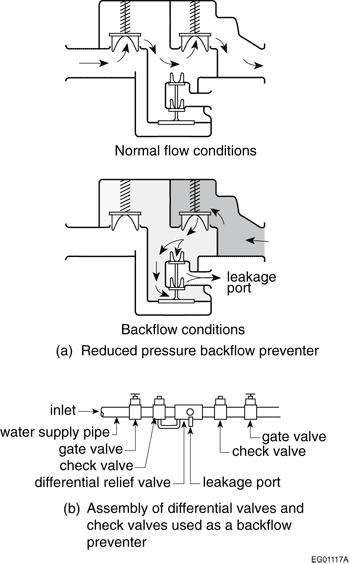
Figure A-1.4.1.2.(1)
-A
Backflow Preventer
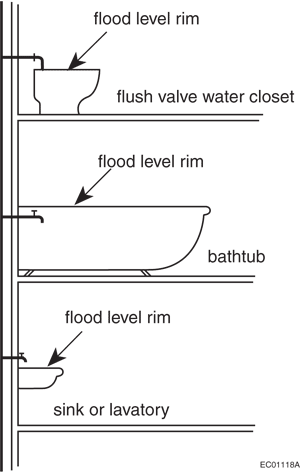
Figure A-1.4.1.2.(1)
-B
Back-Siphonage
Notes to Figure
A-1.4.1.2.(1)
-B
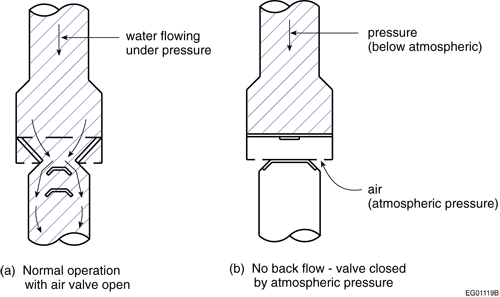
Figure A-1.4.1.2.(1)
-C
Back-Siphonage Preventer
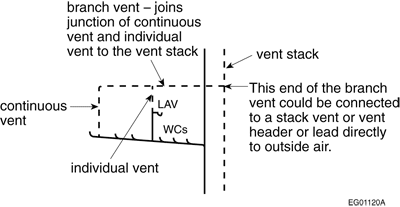
Figure A-1.4.1.2.(1)
-D
Branch Vent
Note to Figure
A-1.4.1.2.(1)
-D

Figure A-1.4.1.2.(1)
-E
Continuous Vent
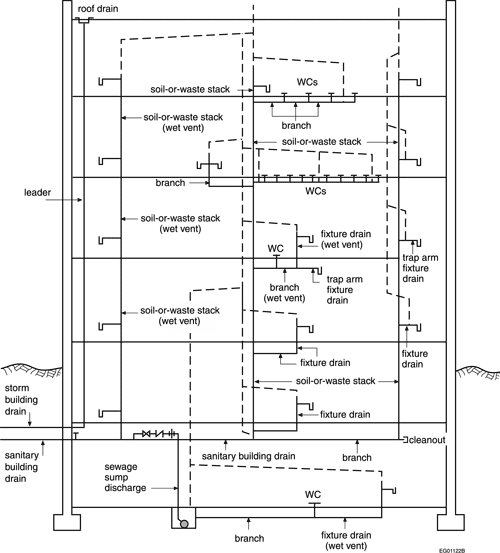
Figure A-1.4.1.2.(1)
-F
Drainage System
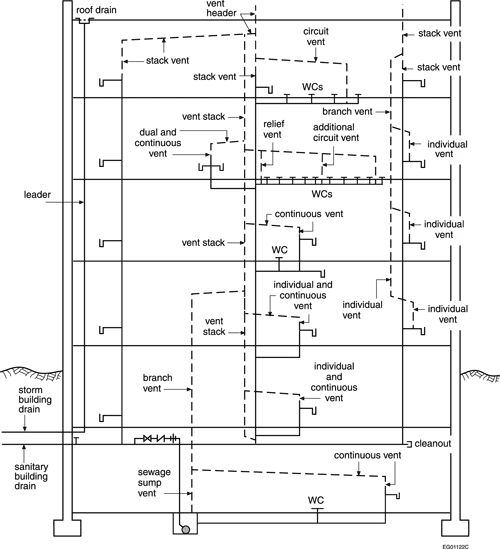
Figure A-1.4.1.2.(1)
-G
Venting System
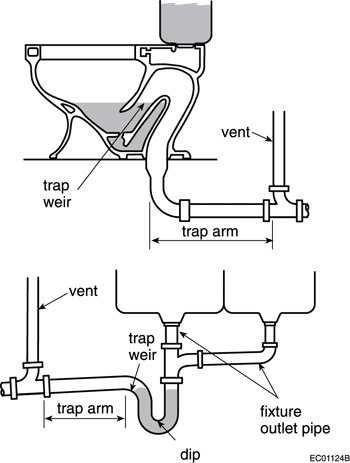
Figure A-1.4.1.2.(1)
-H
Fixture Outlet Pipe and Trap Arm
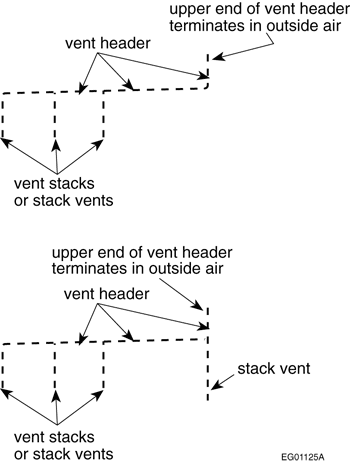
Figure A-1.4.1.2.(1)
-I
Vent Header
Note to Figure
A-1.4.1.2.(1)
-I
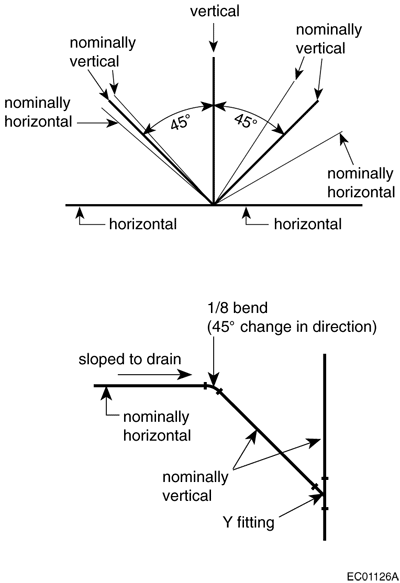
Figure A-1.4.1.2.(1)
-J
Nominally Horizontal and Nominally Vertical
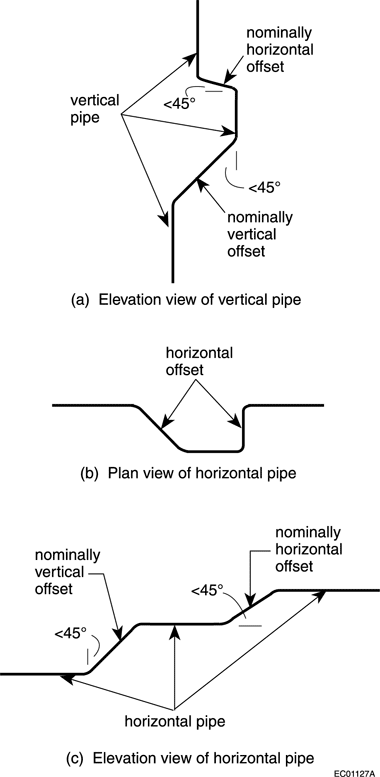
Figure A-1.4.1.2.(1)
-K
Offset
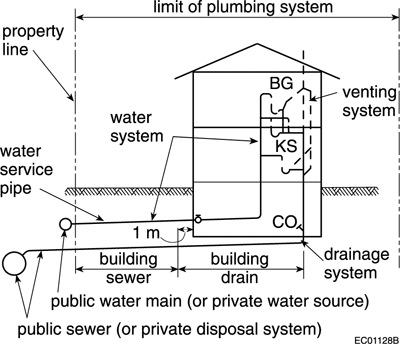
Figure A-1.4.1.2.(1)
-L
Plumbing System
A-1.5.1.1.(1) Application of Referenced Documents. Documents referenced in the VBBL may contain provisions covering a wide range of issues, including issues that are unrelated to the objectives and functional statements stated in Parts
2 and
3 of Division A respectively; e.g. aesthetic issues such as colour-fastness
or
uniformity. Sentence 1.5.1.1.(1) is intended to make it clear that, whereas referencing a document in the VBBL generally has the effect of making the provisions of that document part of
the By-law, provisions that are unrelated to buildings or to the objectives and
functional statements attributed to the provisions in Division B where the document
is referenced are excluded.
Furthermore, many documents referenced in the VBBL contain references to other documents, which may also, in turn, refer to
other documents. These secondary and tertiary referenced documents may contain
provisions that are unrelated to buildings or to the objectives and functional
statements of the VBBL: such provisions — no matter how far down the chain of references they
occur — are not included in the intent of Sentence 1.5.1.1.(1) of Division A.

A-1.5.1.1.(1) Application of Referenced Documents. Documents referenced in the BCBC may contain provisions covering a wide range of issues, including issues
that are unrelated to the objectives and functional statements stated in Parts
2 and
3 of Division A respectively; e.g. aesthetic issues such as colour-fastness or
uniformity. Sentence 1.5.1.1.(1) is intended to make it clear that, whereas referencing a document in the BCBC generally
has the effect of making the provisions of that document part of
the Code, provisions that are unrelated to buildings or to the objectives and
functional statements attributed to the provisions in Division B where the document
is referenced are excluded.
Furthermore, many documents referenced in the BCBC contain references to other documents,
which may also, in turn, refer to
other documents. These secondary and tertiary referenced documents may contain
provisions that are unrelated to buildings or to the objectives and functional
statements of the BCBC: such provisions—no matter how far down the chain of references
they
occur—are not included in the intent of Sentence 1.5.1.1.(1) of Division A.
A-2.2.1.1.(1) Objectives.
Listing of objectives
Any gaps in the numbering sequence of the objectives are due to the
fact that there is a master list of objectives covering the three principal
Vancouver By-law Documents – the Vancouver Building By-law, the Vancouver Fire By-law – but not all objectives are pertinent to all
By-laws.
The building
Where the term “the building” is used in the wording of the
objectives, it refers to the building for which compliance with the Vancouver Building By-law is being assessed.
Emergency
The term “emergency” – in the context of safety in
buildings – is often equated to the term “fire emergency;” however,
the wording of objectives OS3.7 and OS5.9 makes it clear that the By-law addresses
any type of emergency that would require the rapid evacuation of the building,
such as a bomb threat or the presence of intruders.

A-2.2.1.1.(1) Objectives.
Listing of objectives
Any gaps in the numbering sequence of the objectives are due to the
fact that there is a master list of objectives covering the three principal British
Columbia Code Documents – the British Columbia Building Code, the British Columbia
Fire Code – but not all objectives are pertinent to all
Codes.
The building
Where the term “the building” is used in the wording of the
objectives, it refers to the building for which compliance with the British Columbia
Building Code is being assessed.
Emergency
The term “emergency” – in the context of safety in
buildings – is often equated to the term “fire emergency;” however,
the wording of objectives OS3.7 and OS5.9 makes it clear that the Code addresses
any type of emergency that would require the rapid evacuation of the building,
such as a bomb threat or the presence of intruders.
A-3.2.1.1.(1) Functional Statements.
Listing of functional statements
The numbered functional statements are grouped according to
functions that deal with closely related subjects. For example, the first group
deals with fire risks, the second group deals with emergency egress and
response, etc. There may be gaps in the numbering sequence for the following
reasons:
- Each group has unused numbers which allows for the possible future creation
of additional functional statements within any one group.
- There is a master list of functional statements covering the principal Vancouver By-law Documents – the Vancouver Building By-law and the Vancouver Fire By-law – but not all functional statements are pertinent to all By-laws.

A-3.2.1.1.(1) Functional Statements.
Listing of functional statements
The numbered functional statements are grouped according to
functions that deal with closely related subjects. For example, the first group
deals with fire risks, the second group deals with emergency egress and
response, etc. There may be gaps in the numbering sequence for the following
reasons:
- Each group has unused numbers which allows for the possible future creation
of additional functional statements within any one group.
- There is a master list of functional statements covering the principal British Columbia
Code Documents – the British Columbia Building Code and the British
Columbia Fire Code – but not all functional statements are pertinent to all
Codes.
























